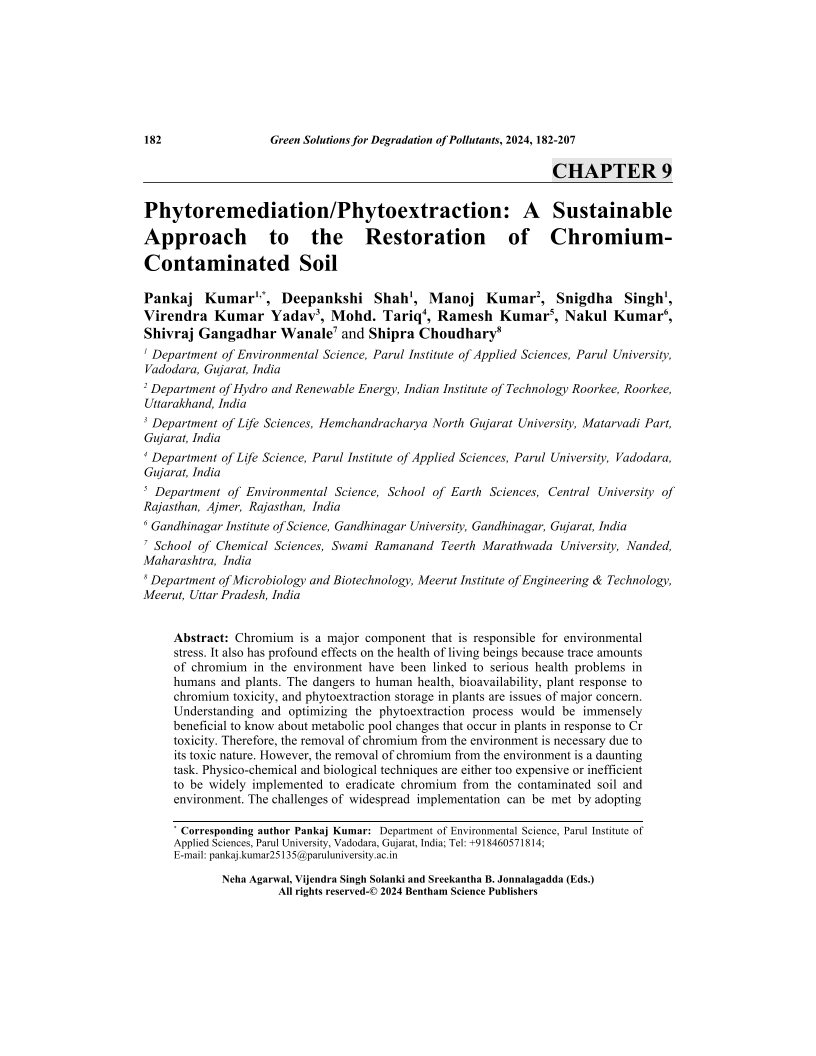Phytoremediation/Phytoextraction: A Sustainable Approach to the Restoration of ChromiumContaminated Soil

- Authors: Pankaj Kumar1, Deepankshi Shah2, Manoj Kumar3, Snigdha Singh4, Virendra Kumar Yadav5, Mohd. Tariq6, Ramesh Kumar7, Nakul Kumar8, Shivraj Gangadhar Wanale9, Shipra Choudhary10
-
View Affiliations Hide AffiliationsAffiliations: 1 Department of Environmental Science, Parul Institute of Applied Sciences, Parul University, Vadodara, Gujarat, India 2 Department of Environmental Science, Parul Institute of Applied Sciences, Parul University, Vadodara, Gujarat, India 3 Department of Hydro and Renewable Energy, Indian Institute of Technology Roorkee, Roorkee, Uttarakhand, India 4 Department of Environmental Science, Parul Institute of Applied Sciences, Parul University, Vadodara, Gujarat, India 5 Department of Life Sciences, Hemchandracharya North Gujarat University, Matarvadi Part, Gujarat, India 6 Department of Life Science, Parul Institute of Applied Sciences, Parul University, Vadodara, Gujarat, India 7 Department of Environmental Science, School of Earth Sciences, Central University of Rajasthan, Ajmer, Rajasthan, India 8 Gandhinagar Institute of Science, Gandhinagar University, Gandhinagar, Gujarat, India 9 School of Chemical Sciences, Swami Ramanand Teerth Marathwada University, Nanded, Maharashtra, India 10 Department of Microbiology and Biotechnology, Meerut Institute of Engineering & Technology, Meerut, Uttar Pradesh, India
- Source: Green Solutions for Degradation of Pollutants , pp 182-207
- Publication Date: August 2024
- Language: English
Phytoremediation/Phytoextraction: A Sustainable Approach to the Restoration of ChromiumContaminated Soil, Page 1 of 1
< Previous page | Next page > /docserver/preview/fulltext/9789815238969/chapter-9-1.gif
Chromium is a major component that is responsible for environmental stress. It also has profound effects on the health of living beings because trace amounts of chromium in the environment have been linked to serious health problems in humans and plants. The dangers to human health, bioavailability, plant response to chromium toxicity, and phytoextraction storage in plants are issues of major concern. Understanding and optimizing the phytoextraction process would be immensely beneficial to know about metabolic pool changes that occur in plants in response to Cr toxicity. Therefore, the removal of chromium from the environment is necessary due to its toxic nature. However, the removal of chromium from the environment is a daunting task. Physico-chemical and biological techniques are either too expensive or inefficient to be widely implemented to eradicate chromium from the contaminated soil and environment. The challenges of widespread implementation can be met by adopting integrated approaches, which are currently under consideration. The removal of chromium from the environment can be more economical and sustainable using phytoremediation technology. In this chapter, we have discussed the phytoremediation technique as a green solution for the removal of chromium from polluted soil because phytoremediation, and especially phytoextraction, is a viable and sustainable solution to restore chromiumpolluted soil.
-
From This Site
/content/books/9789815238969.chapter-9dcterms_subject,pub_keyword-contentType:Journal105

